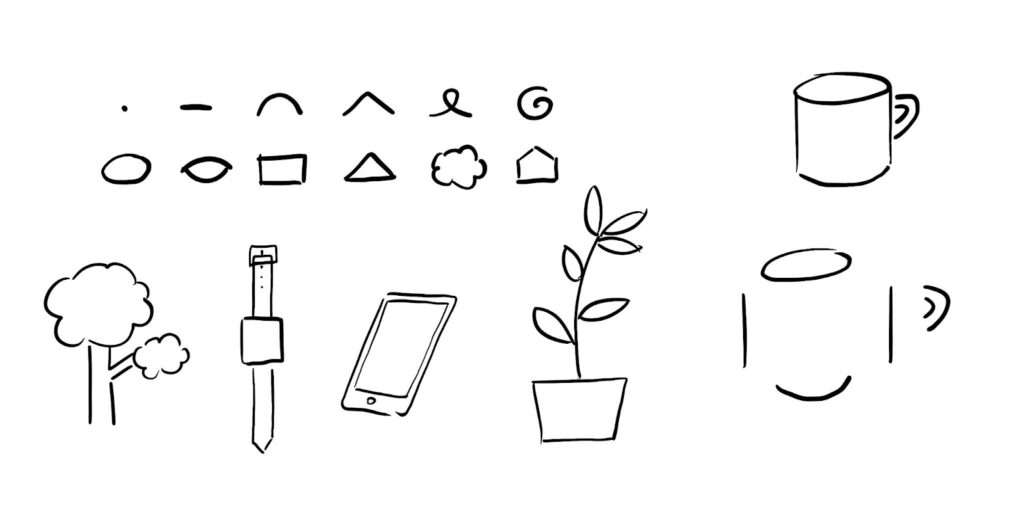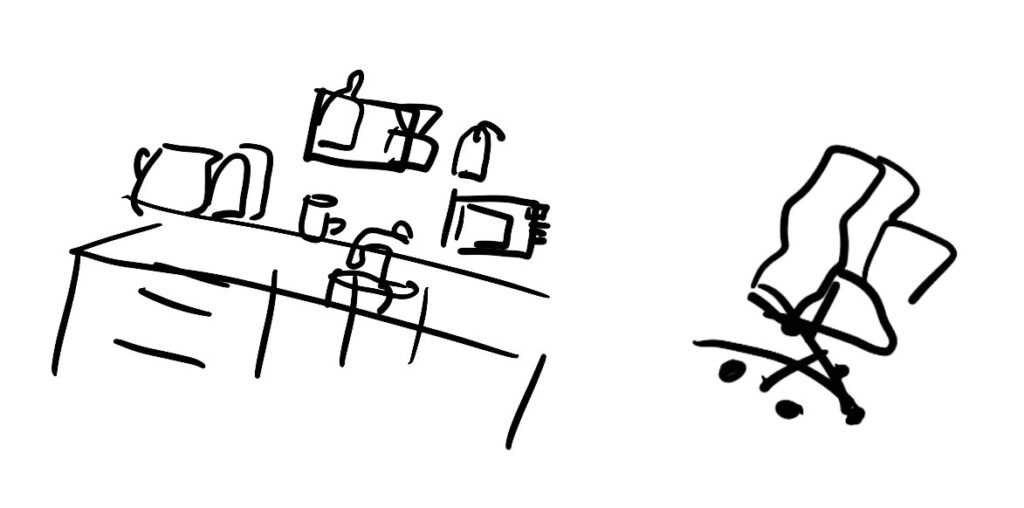At Sketch Group, we’re all about using drawing as a tool for communication, not just for creating beautiful art. Our visual work—whether it’s an explainer video, a strategy poster, or live graphic recording—focuses on simplifying complex ideas and making them easy to understand. Behind every successful sketch is hours of practice, refining the skills needed to communicate visually. Here’s a look at some of the exercises we use, and you can too, to strengthen your drawing for communication.
Beginning Drawing Exercises: Mastering the Basics for Communication
Using The Visual Alphabet
When we teach visual thinking in our workshops, we always start with the basics. One of the first drawing exercises we introduce in our visual thinking training is drawing the visual alphabet, a concept introduced by Dave Gray in the seminal design thinking book Gamestorming.

These simple shapes—lines, circles, triangles, squares, dots, and other easy-to-draw symbols—form the foundation of nearly every drawing. The theory is that by building upon these shapes—repeating, rotating, overlapping, stretching, and combining them—we can draw pretty much anything.
Foundation Shapes
Breaking down objects into their basic shapes is another fundamental exercise we use. If we’re drawing a person, for instance, we start with ovals for the head and torso, rectangles for the limbs, and cylinders for the arms and legs. This method helps us see the underlying structure of an object and makes it easier to draw it quickly and effectively. It’s all about capturing the essence of the object in a simplified way to communicate a message.
Basic Drawing Exercises to Build Observation and Simplification Skills
To improve our ability to observe and simplify what we see, we do several key exercises. One of our favorites is blind contour drawing. In this exercise, we draw the outline of an object without looking at the paper. It’s a humbling experience that often results in wonky lines, but it trains our eyes and hands to work together and helps us see shapes more accurately.

We also practice drawing negative space. Instead of focusing on the object itself, we sketch the empty spaces around it. For instance, instead of drawing a chair, we draw the gaps between the chair legs and backrest. This exercise improves our understanding of spatial relationships and helps us compose clearer, more balanced drawings.
Another valuable exercise is the five-minute sketch. We set a timer and draw as much as we can in just five minutes, focusing on capturing the most important elements. This is excellent practice for simplifying details and getting our point across efficiently, which is crucial in our fast-paced world of visual communication.
Drawing Practice Exercises for Developing Visual Vocabulary
To communicate effectively with drawings, having a solid visual vocabulary is key. Creating and refining symbols that you can use to represent common concepts means you don’t have to think “what should I draw for that?” You’ve already got an icon that you know how to draw, ready to pull out and use. This could include how you draw physical objects, like people, cars, trees, or houses, and visual metaphors for more abstract concepts (e.g. a light bulb to represent idea, arrows to show movement, or a clock to indicate time).

We also practice removing detail to represent more complex scenes. This involves taking everyday objects or scenarios and breaking them down into simple, recognizable parts. For instance, drawing a busy street scene might start with rectangles for buildings, ovals for car wheels, and basic figure outlines to show a crowd of people. By simplifying in this way, we can focus on communicating the core elements of the scene.
Another exercise we find helpful is practicing quick thumbnails for ideas. We take a concept—like teamwork or growth—and sketch several different ways to represent it visually, using only simple shapes and lines. This kind of brainstorming helps us think visually and quickly generate ideas that are easy to understand.
Practicing Drawing Anytime, Anywhere
Drawing practice doesn’t have to be formal or time-consuming. We incorporate sketching into our daily routines, finding moments to practice visual thinking wherever we are. On public transport, we might quickly sketch the people around us, capturing their gestures with simple lines. During lunch breaks, we doodle objects nearby, reducing them to basic shapes to sharpen our simplification skills. Even in meetings, we practice sketching concepts as we hear them, turning words into images in real time.
We also recommend keeping a small sketchbook handy to jot down ideas and observations as they come to you. Practicing this way makes drawing feel natural and prepares you to communicate visually on the fly. It’s less about making perfect drawings and more about developing the ability to simplify and communicate ideas visually.
Drawing to Communicate, Not to Impress
At Sketch Group, we always emphasize that drawing is a tool for communication. The handful of exercises mentioned here are designed to improve our ability to convey concepts clearly and effectively, not to create gallery-worthy art. By practicing foundational shapes, building a visual vocabulary, and honing our observation skills, we’ve developed techniques that help us simplify the complex. Hopefully you find them useful as well!
Remember, the goal isn’t perfection; it’s clarity. Embrace these exercises and keep practicing, and you’ll find yourself better equipped to use drawing as a powerful means of communication.

